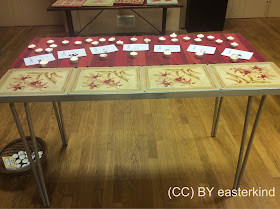This week leading up to Pentecost has been a
week of prayer in the Church of England. Activities have ranged from novenas to 24-7 prayer rooms, from
Lectio Divina to neighbourhood prayer walks. To involve my church, I scheduled a prayer activity for each weekday this week. Three of these were services at the church. But I also offered to do "themed devotions" for our two children's ministries this week.
These are not children accustomed to Godly Play; most of them are not even accustomed to attending church. Our ministry includes opening prayers and some teaching about the Christian faith, but most of the time is spent on games and other activities.
I chose to use part of the Pentecost Celebration from Catechesis of the Good Shepherd. This is something I learned about
back in October 2013, and already then I was excited and intrigued about using it with others. The goal was to invite each child to a prayerful moment, one which could be understood as a prayer for renewal by the Holy Spirit (which is one of the themes of our week of prayer).
I began by super-briefly reminding children of the Christian concept of the Trinity, and reading Isaiah 11:2. I then listed the seven gifts of the Holy Spirit, showing cards I had prepared. These included illustrations to help non-readers. I lit seven candles placed by the cards. I started playing a cd of Taizé chants (starting with one on the theme of the Holy Spirit), and invited each person to come forward, one at a time, and light a candle of their own from the candle of one of the gifts. This would be their prayer for more of that gift.
It wasn't entirely smooth and ideal. The boys poked each other and stage-whispered, "Fire-POWER!" One teenage girl announced that she didn't know how to pick because they were all about God and she was an atheist. The "taper" dribbled far more wax than I had predicted, and some of the tea lights were surprisingly hard to light.
But, each person present did come forward and light a candle. While the group atmosphere was not consistently reverent, almost everyone was serious about their own turn at lighting a candle. Most of them took time to select which gift they would choose. Although I had included illustrations so that non-readers might choose meaningfully from amongst the cards, I was also aware of the advice from Catechesis training that for some children the solemn lighting of a candle would be meaningful enough without fretting over the extent to which they had understood the choice to be made.
After doing it with the first group, I realised that it was best to have the table positioned so that those lighting candles were facing away from the rest of the children. Something that did work well was having them blow out the taper once they'd lit their own candle, and then hand the taper to someone else who would then come forward for their turn.
Once all the children had lit candles, I asked them to invite the staff to do so as well. And it was clearly a moving and meaningful activity for them, too.
_side%3B_Lowell%2C_MA%3B_2012-05-18.jpg)


